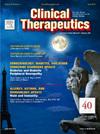美国非2型糖尿病患者使用替西肽的特点和治疗模式
IF 3.6
4区 医学
Q2 PHARMACOLOGY & PHARMACY
引用次数: 0
摘要
目的:本研究的目的是了解在美国MerativeTM MarketScan®商业(MarketScan)和Optum Clinformatics索赔(CDM)数据库中,替泽肽在无2型糖尿病(T2D)诊断人群中的实际使用情况。方法:这项回顾性、观察性、描述性研究使用了来自MarketScan和Optum CDM数据库的数据(索引日期:首次观察到的替泽肽索赔),时间为2021年5月至2023年9月。主要入选标准包括年龄≥18岁,替西帕肽声明≥1次,无基线T2D诊断代码或降糖药物使用(二甲双胍除外),指数前连续医疗和药房登记≥12个月。在指数日期评估人口统计学特征,而在指数前12个月期间确定临床特征和治疗相关数据。对开始替泽肽治疗(指标日期)后随访≥6个月的个体进行替泽肽持久性和利用率(指标后6个月)评估。对每个数据库的数据分别进行分析。结果:总体而言,在MarketScan数据库中确定了15,534名符合条件的成年人,在Optum CDM数据库中确定了6800名;平均年龄分别为46.2岁和55.9岁,在两个数据库中,70%为女性。共有70.6% (MarketScan)和81.0% (Optum CDM)的个体至少有一种与肥胖相关的并发症,其中最常见的是高血压、血脂异常和糖尿病前期。随访≥6个月,MarketScan数据库中有8709人,Optum CDM数据库中有3384人。在这两个数据库中,大约三分之二的人开始服用2.5毫克,到第六次处方时,最常见的替泽帕肽剂量是5毫克和7.5毫克。在两个数据库中,替西帕肽的持久性范围为60.6%至75.7%,处方间隔为45天或60天。在停用替西帕肽的个体中,10.2-19.5%在6个月的随访期间重新开始使用替西帕肽。意义:在这两个数据库中,大多数未被诊断为T2D的患者开始使用替西帕肽,且伴有≥1种肥胖相关并发症,这表明替西帕肽正被用于多病患者。高比例的开始使用tizepatide的患者持续治疗6个月,这高于先前报道的胰高血糖素样肽-1受体激动剂。本文章由计算机程序翻译,如有差异,请以英文原文为准。
Characteristics and Treatment Patterns of People Without Type 2 Diabetes Diagnoses Who Use Tirzepatide in the United States
Purpose
The purpose of this study was to understand real-world use of Tirzepatide among people without type 2 diabetes (T2D) diagnoses in the United States in the MerativeTM MarketScan® Commercial (MarketScan) and Optum Clinformatics Claims (CDM) databases.
Methods
This retrospective, observational, descriptive study used data from the MarketScan and Optum CDM databases (index date: first-observed Tirzepatide claim) from May 2021 to September 2023. Key eligibility criteria included age ≥18 years, ≥1 Tirzepatide claim, no baseline T2D diagnosis codes or antihyperglycemic medication use (except metformin), and continuous medical and pharmacy enrollment for ≥12 months pre-index. Demographic characteristics were assessed at the index date, while clinical characteristics and treatment-related data were identified during the 12-month pre-index period. Tirzepatide persistence and utilization (6 months post index) were assessed for individuals with ≥6 months of follow-up after initiation of Tirzepatide treatment (index date). Data were analyzed separately for each database.
Findings
Overall, 15,534 eligible adults were identified in the MarketScan database and 6800 in the Optum CDM database; mean age was 46.2 years and 55.9 years, respectively, and in both databases, >70% were female. A total of 70.6% (MarketScan) and 81.0% (Optum CDM) of individuals had at least one obesity-related complication, with the most prevalent being hypertension, dyslipidemia, and pre-diabetes. There were 8709 individuals in the MarketScan database and 3384 in the Optum CDM database with ≥6 months of follow-up. In both databases, approximately two-thirds of people were started on 2.5 mg and, by the sixth prescription fill, the most common doses of Tirzepatide were 5 mg and 7.5 mg. Tirzepatide persistence ranged from 60.6% to 75.7% across both databases, with an allowed gap between prescriptions of 45 days or 60 days. Of individuals who discontinued tirzepatide, 10.2–19.5% restarted Tirzepatide during the 6-month follow-up.
Implications
In both databases, most people initiating Tirzepatide without T2D diagnoses had ≥1 obesity-related complication, indicating that Tirzepatide is being used in people with multimorbidity. A high proportion of people who initiated Tirzepatide were persistent on treatment at 6 months, which is higher than that previously reported for glucagon-like peptide-1 receptor agonists.
求助全文
通过发布文献求助,成功后即可免费获取论文全文。
去求助
来源期刊

Clinical therapeutics
医学-药学
CiteScore
6.00
自引率
3.10%
发文量
154
审稿时长
9 weeks
期刊介绍:
Clinical Therapeutics provides peer-reviewed, rapid publication of recent developments in drug and other therapies as well as in diagnostics, pharmacoeconomics, health policy, treatment outcomes, and innovations in drug and biologics research. In addition Clinical Therapeutics features updates on specific topics collated by expert Topic Editors. Clinical Therapeutics is read by a large international audience of scientists and clinicians in a variety of research, academic, and clinical practice settings. Articles are indexed by all major biomedical abstracting databases.
 求助内容:
求助内容: 应助结果提醒方式:
应助结果提醒方式:


